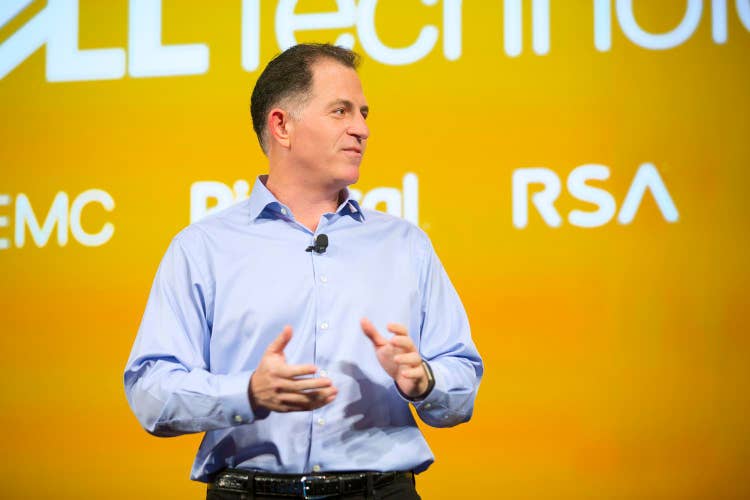Michael Dell: COVID-19 Caused Public Cloud ‘Fast Route’, But Multi-Cloud Will ‘Resonate’
‘When it came to expanding infrastructure capability [when COVID-19 happened], the fastest way was what customers often went for – in many cases that was public cloud,’ says Dell Technologies CEO Michael Dell.

Dell Technologies CEO Michael Dell said the coronavirus pandemic caused many organizations to quickly seek public cloud solutions when it came to expanding infrastructure capabilities to meet the needs of a new remote workforce without any planning regarding cost and workload optimization.
“What happened during the crisis was that organizations went to the fast route with everything they were doing because they didn’t really have any other good options. So when it came to work from home, it was like, ‘OK, take your PC, stick it under your arm and go to your house.’ There wasn’t a lot of preparation or planning or thought,” said Dell in an interview with CRN. “So when it came to expanding infrastructure capability, the fastest way was what customers often went for – in many cases that was public cloud.”
However, the legendary IT leader expects customers to eventually shift their investments and long-term strategy towards multi-cloud as businesses begin to take a serious look at their public cloud bill and workload cost efficiencies.
“As customers go back and look at that capability, they kind of say, ‘Well, how do I optimize this? And how to I make all of these things work efficiently together? I still have some on-premise infrastructure and I want to seamlessly move workloads around. And at the same time, as I now get the bills coming in for all of these things, I understand certain workloads are going to be more efficient on-premise. Certainty workloads might be more efficient in the public cloud, and I want those to all work together smoothly,’” said Dell. “That’s where we’re seeing VMware Cloud Foundation and the whole multi-cloud approach that we’re taking really resonate.”
[Related: Dell To Make ‘All Offerings’ As-A-Service, Says Michael Dell]
Scott Miller, senior director of strategic partnerships at World Wide Technology, a $12 billion Maryland Heights, Mo.-based channel powerhouse, agreed with Michael Dell that some businesses rushed to public cloud when COVID-19 disrupted the workforce.
“I do think there were some unique examples where people ran to public cloud because they just couldn’t get access to assets. If you didn’t have a work from home initiative, and you couldn’t get a hyperconverged infrastructure purchased or shipped – or even if you could, you couldn’t get the human resources to show up in a data center to work on the physical building – public cloud was a path to least resistance,” said WWT’s Miller.
After more than six months into the coronavirus pandemic, Miller said some customers are now rethinking their IT strategies.
“I’m having a lot of these conversations today, the bills are coming in and the customers are saying, ‘Holy crap! Nobody explained to me about the egress costs and all these other things.’ So there’s some repatriation,” said WWT’s Miller. “However, not all customers are going to do that.”
In terms of workload costs, both Miller and Dell agree that it depends on the specific workload as to whether its most cost efficient in the public cloud versus on-premise.
In 2018, Michael Dell said software-defined data center on-premises solutions are more cost-effective than public cloud for 85 percent of workloads. When asked by CRN if that 85 percent statistic still holds up, Dell said it does, depending on the workload and industry.
“It’s going to vary by workload and by industry. If you look at banks, lots of banks repeat the kind of statistics you just mentioned,” Dell said.
The Round Rock, Texas-based $92 billion infrastructure giant believes hybrid cloud and multi-cloud is the future for all organizations. Dell Technologies offers a slew of end-to-end hybrid cloud platforms including the Dell Technologies Cloud as well as various joint integrated solutions with VMware, which Dell owns a majority stake in.
Looking at the data center market in the second quarter of 2020, public cloud data center hardware and software spending from public cloud titans like AWS, Google and Microsoft reached an all-time-high despite COVID-19, while enterprise spending decreased.
Spending on public cloud data center infrastructure jumped 25 percent year over year to nearly $17 billion in second quarter 2020, according to data from Synergy Research Group. On the other hand, enterprise data center spending on hardware and software dropped 3 percent year over year to $24.4 billion.
WWT’s Miller said it’s going to be interesting to see just how many businesses pull back on public cloud spending when the coronavirus pandemic begins to settle down.
“When COVID-19 happened, it was like, ‘I know I can do this way more cost effectively and cheaper and faster normally on-premise, but it’s not an option and I’ve got to get the workload up. So I have really no other option,’” said Miller. “The question will be, do businesses just continue to pay a premium to be in the public cloud, or when things start to settle down over time and you get human bodies back together again to work on IT and data centers, do they start pulling those things back to the data center? It will be interesting to watch.”